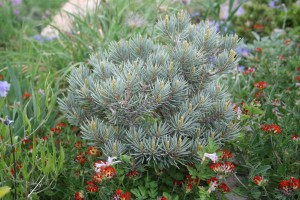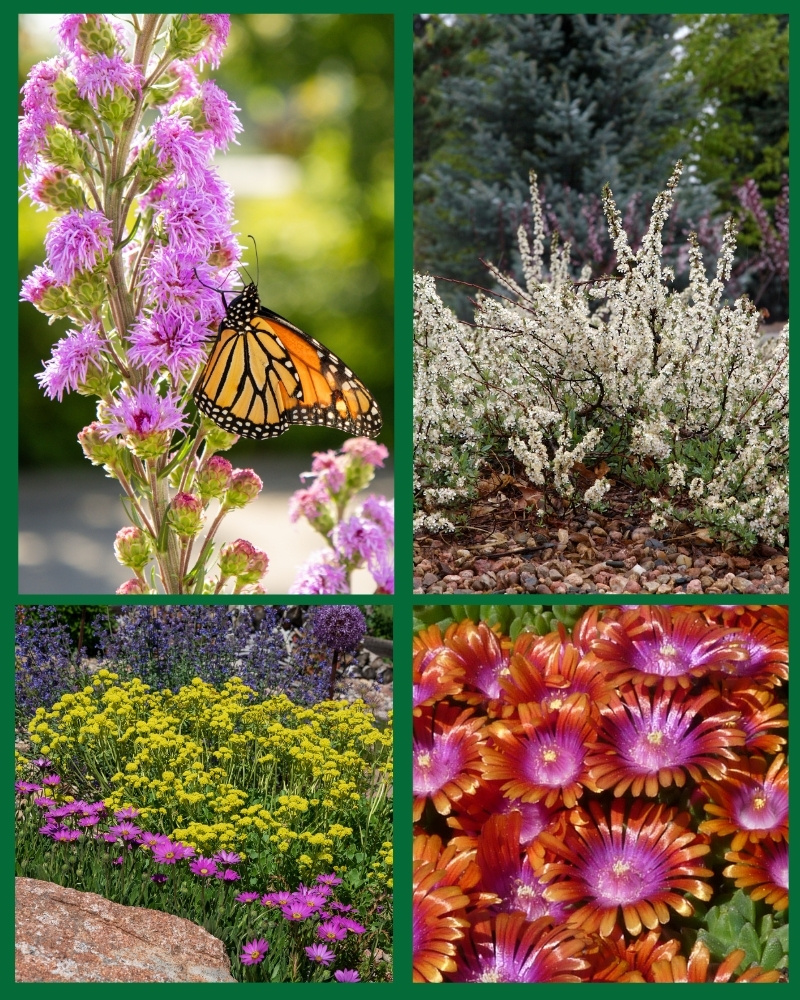Blue Jazz Pinon Pine – A Cool Note for a Hot Garden
 Blue Jazz piñon pine is a dwarf selection of piñon pine (Pinus monophylla) that features pointed blue-toned needles that curve upwards towards the sky and an overall teardrop shape that adds a unique texture and color to the landscape. It was selected by renowned dwarf conifer expert Jerry Morris at a location west of Sacramento Pass near Baker, NV at about 8,000 feet in elevation.
Blue Jazz piñon pine is a dwarf selection of piñon pine (Pinus monophylla) that features pointed blue-toned needles that curve upwards towards the sky and an overall teardrop shape that adds a unique texture and color to the landscape. It was selected by renowned dwarf conifer expert Jerry Morris at a location west of Sacramento Pass near Baker, NV at about 8,000 feet in elevation.
This selection is a single needle form of piñon pine, a group of trees known to survive for hundreds of years. They’ve evolved to exhibit single-needled leaves in order to conserve water, while most other pines exhibit multiple needles per bundle (or fascicle). This xeric treasure is a great choice for all water conscious gardeners who recognize the growing concerns of water resources in our region and seek a plant that is unusual, compact in size and evergreen.
Plant this little beauty in hot, dry locations where reflective heat may have been a problem or in rock gardens where an evergreen element is desired. Blue Jazz is a tough resilient plant, but is best in locations with light or no foot traffic, as broken branches can affect the overall shape and habit. Simply put, this plant is a must have for all xeric landscapes. Over time Blue Jazz grows slowly and steadily and will be a distinctive stand out in the landscape, much like Louis Armstrong in a jazz ensemble.
Blue Jazz piñon pine
Pinus monophylla ‘Blue Jazz’
Dwarf conifer
Size: 24ʺ x 24″ (Grows only 2-6ʺ per year)
Sun: Full sun to part shade
Water: Dry to Xeric
Hardiness: USDA zones 4-7
Culture: Well-drained, sandy soil
Pairs Well With:
• Turquoise Tails sedum
• Mock Bearberry manzanita
• Scott’s sugarbowls
Thanks to Ross Shrigley for this piece



Where can I buy Blue Jazz piñon pine? I live in Durango, CO.
Kirk Fieseler at Laporte Avenue Nursery, Fort Collins, sells them wholesale. I’ve got a query into him about retail sales or who he ships to down your way. Will let you know when I hear back!
Ditto. Also live in Durango Colorado and wanting to get some blue jazz pinion pines.
Contact the folks at Durango Nursery and Supply. They bring them in from Laporte Ave. nursery. Laporte may ship them to you directly if you reach out to them. http://www.laporteavenuenursery.com/
[…] Lucky for us, noted Denver plantsman and dwarf conifer expert Jerry Morris has introduced several naturally occurring witches’ brooms into cultivation. They make perfect specimens for gardens of all sizes. One of the most popular being Pinus monophylla, “Blue Jazz” — a dwarf pinyon pine from the popular Plant Select Program. Read more at http://plantselect.org/plantstories/blue-jazz-a-cool-note-for-a-hot-garden/ […]
I’ve got a blue jazz that appears to be showing stress that I think might be the effects of last fall’s temperature swings/deep freeze. I’ve read that fertilizing is not recommended for pinyon pines, but I’ve also read that fertilizer might help evergreens recover from the deep freeze. Looking for info on what fertilizer, if any, to use. Any advice on how to help my blue jazz thrive?
Last fall’s early freeze and this year’s late freeze have been tremendously hard on lots of plants. To give this plant immediate strength, you can use a liquid fertilizer that is not high in nitrogen. A general liquid fertilizer used on indoor plants works well. Every other week, use a watering can and pour the mixture on top of the plant so that it covers the leaves and drips to the roots. The needles will actually absorb the nutrients quicker than giving the nutrients to the roots. This should help. Good luck!
Does Blue Jazz provide edible nuts like larger pinon pines?
Yes, it will eventually, 20+ years?
Is this a dwarf Pinus Monophylla or the usual? The Pinus Monophylla that grow in the Pine Nut Range in California and Nevada only 1-2 inches per year when young but will eventually (presumably after several hundred years) reach 20+ feet high with a 30 foot spread.
I find the seedlings very challenging to transplant due to a very long tap root (may be several times as long as the tree is high) combined with incredibly fragile spreading roots. Only seems to grow well in sandy soil or just straight up sand. Seedlings will also only grow in shade.
Can these be container grown and/or grown indoor or will the tap root get out of control?
Blue Jazz is uniquely dwarf and blueish. All P. monophylla typical have very, very blue first-year growth, but then fade to green as they mature. Blue Jazz stays blueish in maturity and only grows about 2-6 inches per year. Dwarf trees are usually defined by their growth habit, with growth less than 6 inches per year. Blue Jazz can be grown in a container for many years in the correct media but will have to experience a winter dormant period to stay healthy. Leave the container outside in the winter. Also, be sure to use porous media in the container. More like a cactus potting media mixed with some organics in it, not the typical straight potting mix used for growing annuals.